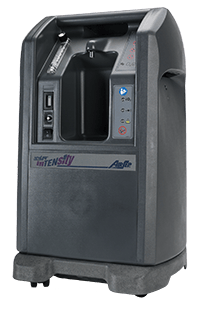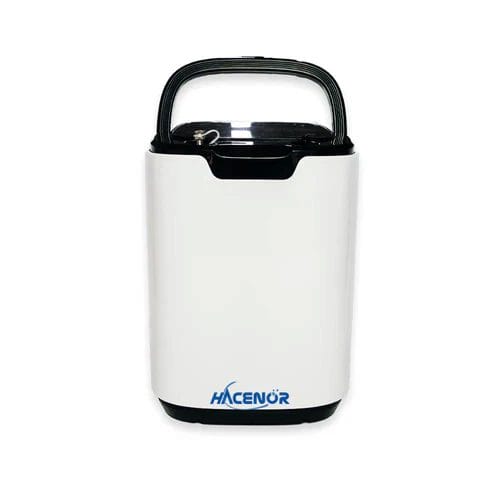
Having a home oxygen concentrator can increase your quality of life, giving you back some of your energy so you can participate in the activities you love, even with a medical condition like COPD or heart failure. Regardless of what kind of home oxygen concentrator you have, it’s important to care for it properly so it can continue to provide you with symptom relief. Here’s what you need to know about how to care for your home oxygen concentrator, along with how to avoid common mistakes that can decrease its lifespan.
You should always consult your machine’s user manual before performing any maintenance to check for variations in how to care for it.
Keep the outside of the oxygen concentrator clean
Oxygen concentrators need to be cleaned regularly. Use a damp washcloth to wipe away dust, pet hair, and debris from the outside of your oxygen concentrator. If your machine is particularly dirty, use a little bit of mild dish detergent when you wipe the case. Then, go back over the case with a damp cloth to wipe away any remaining detergent.
You should consult your specific user manual, as there are some differences when caring for different machines. For example, the exterior of the OxyGo OxyHome can be disinfected with an antibacterial wipe.
Properly cleaning the exterior helps you avoid performance issues and safety risks. Cleaning your home oxygen concentrator with harsh chemical disinfectants, like bleach, can degrade the plastic and rubber components, eventually compromising the machine’s ability to run properly. Alcohol-based cleaners are flammable, which is dangerous around an oxygen source. Using only water and potentially a little bit of mild dish detergent ensures your home oxygen concentrator runs like it’s supposed to without the risk of fire.
Clean and replace the gross particle filter
Nearly every home oxygen concentrator has a gross particle filter. It is usually made of foam and is designed to stop dust, particles, and pet hair from entering your concentrator. It should be removed and cleaned on a weekly basis as follows:
- Turn off and unplug the oxygen concentrator.
- Locate the filter and remove it.
- Wash it with warm water and mild dish soap.
- Rinse thoroughly to remove the soap.
- Let it air-dry completely before replacing it.
It can be a good idea to have an extra filter on hand so that you can continue using the machine while the other filter is wet.
It is important to look at the manual for your particular machine, as there are a few exceptions. For instance, the HACENOR HOC-02 has cotton filters that don’t need to be cleaned. Instead, they should be replaced every three months.
Even if your oxygen concentrator has a cleanable filter, it should still be replaced if it does not rinse clean or looks deformed. It’s also a good idea to replace your existing filter with a brand-new one every year, regardless of its appearance.
Following these tips helps maintain air quality. A clogged filter has the potential to reduce oxygen purity and output and can harbor harmful bacteria, mold, and allergens.
Place your home oxygen concentrator in a well-ventilated space
A home oxygen concentrator filters the nitrogen and other gases out of the ambient air to deliver purified oxygen to the user. In order to do this properly, the machine needs to be in a well-ventilated space.
- Make sure there is between 6 and 12 inches of space around the unit.
- Avoid placing it in a small area, like a bathroom.
- Keep it away from furniture, walls, and curtains.
Keeping the concentrator in a well-ventilated space avoids straining the motor and internal components. A machine that isn’t well-ventilated can overheat and cause a malfunction or a shutdown.
Clean and maintain the nasal cannula and tubing
In addition to caring for the oxygen concentrator itself, it’s important to keep your nasal cannula and tubing clean. The nasal cannula should be cleaned once a week. To clean the nasal cannula:
- Mix a few drops of mild dish detergent in water.
- Soak the nasal cannula in the mixture for a few minutes.
- Use a cloth or cotton swab to clean the nozzle.
- Rinse the soap from the cannula, and set it on a towel to dry.
- Fill a container with one part vinegar to ten parts water.
- Soak the nasal cannula in the mixture to disinfect it.
- After a few minutes, rinse the cannula and set it on a towel to dry before using it again.
The American Lung Association recommends replacing your cannula every two to four weeks and anytime you get sick.
Tubing does not need to be cleaned, but it should be replaced every two months. It’s also important to use the right length of tubing for your machine. Every machine can handle a specific length before the oxygen delivery is compromised. Consult your manual to see what length of tubing is recommended. For example, the CAIRE NewLife Intensity can support up to 200 feet of tubing, which is much longer than other machines.
Properly caring for your cannula and tubing helps you avoid getting sick and ensures the proper flow of oxygen. Regular cleaning and replacement prevent the growth of bacteria and ensure dust, mucus, and other debris don’t clog the tubing.
Consult the manual before conducting any cleaning or maintenance activities
These tips are relevant for most home oxygen concentrators, but it’s always a good idea to consult your manual. Some machines have specialized care and maintenance tasks that go above and beyond the tips mentioned here. With these tips and your user manual, you can ensure that your machine functions optimally and keeps you healthy while receiving the oxygen you need.








